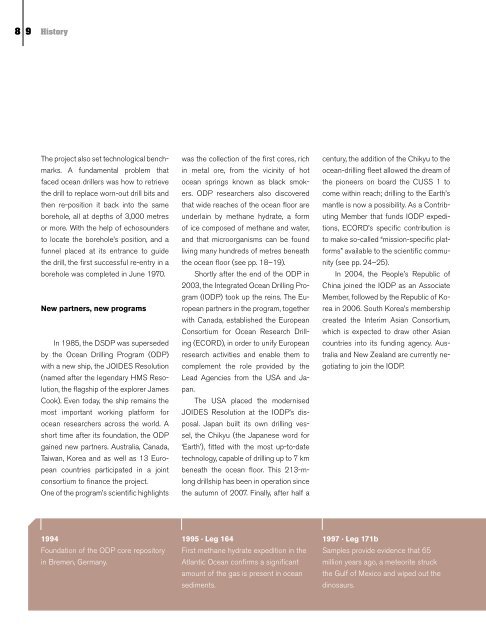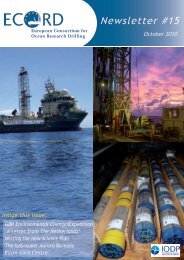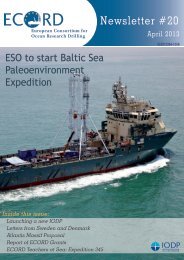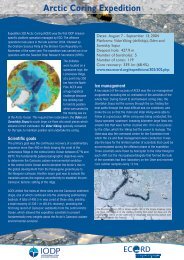printable version - European Consortium for Ocean Research Drilling
printable version - European Consortium for Ocean Research Drilling
printable version - European Consortium for Ocean Research Drilling
- No tags were found...
You also want an ePaper? Increase the reach of your titles
YUMPU automatically turns print PDFs into web optimized ePapers that Google loves.
8 9 HistoryJOIDES Resolution (from 1983)The project also set technological benchmarks.A fundamental problem thatfaced ocean drillers was how to retrievethe drill to replace worn-out drill bits andthen re-position it back into the sameborehole, all at depths of 3,000 metresor more. With the help of echosoundersto locate the borehole’s position, and afunnel placed at its entrance to guidethe drill, the first successful re-entry in aborehole was completed in June 1970.New partners, new programsIn 1985, the DSDP was supersededby the <strong>Ocean</strong> <strong>Drilling</strong> Program (ODP)with a new ship, the JOIDES Resolution(named after the legendary HMS Resolution,the flagship of the explorer JamesCook). Even today, the ship remains themost important working plat<strong>for</strong>m <strong>for</strong>ocean researchers across the world. Ashort time after its foundation, the ODPgained new partners. Australia, Canada,Taiwan, Korea and as well as 13 <strong>European</strong>countries participated in a jointconsortium to finance the project.One of the program’s scientific highlightswas the collection of the first cores, richin metal ore, from the vicinity of hotocean springs known as black smokers.ODP researchers also discoveredthat wide reaches of the ocean floor areunderlain by methane hydrate, a <strong>for</strong>mof ice composed of methane and water,and that microorganisms can be foundliving many hundreds of metres beneaththe ocean floor (see pp. 18–19).Shortly after the end of the ODP in2003, the Integrated <strong>Ocean</strong> <strong>Drilling</strong> Program(IODP) took up the reins. The <strong>European</strong>partners in the program, togetherwith Canada, established the <strong>European</strong><strong>Consortium</strong> <strong>for</strong> <strong>Ocean</strong> <strong>Research</strong> <strong>Drilling</strong>(ECORD), in order to unify <strong>European</strong>research activities and enable them tocomplement the role provided by theLead Agencies from the USA and Japan.The USA placed the modernisedJOIDES Resolution at the IODP’s disposal.Japan built its own drilling vessel,the Chikyu (the Japanese word <strong>for</strong>‘Earth’), fitted with the most up-to-datetechnology, capable of drilling up to 7 kmbeneath the ocean floor. This 213-mlongdrillship has been in operation sincethe autumn of 2007. Finally, after half acentury, the addition of the Chikyu to theocean-drilling fleet allowed the dream ofthe pioneers on board the CUSS 1 tocome within reach; drilling to the Earth’smantle is now a possibility. As a ContributingMember that funds IODP expeditions,ECORD’s specific contribution isto make so-called “mission-specific plat<strong>for</strong>ms”available to the scientific community(see pp. 24–25).In 2004, the People’s Republic ofChina joined the IODP as an AssociateMember, followed by the Republic of Koreain 2006. South Korea’s membershipcreated the Interim Asian <strong>Consortium</strong>,which is expected to draw other Asiancountries into its funding agency. Australiaand New Zealand are currently negotiatingto join the IODP.Length of retrieved cores 333 kmNumber of cores 37,598Number of boreholes 1,901Expeditions 120Deepest borehole2,111 mGreatest water depth5,980 mTotal distance covered384,577 nautical miles(712,239 km)Chikyu (from 2007)Length of retrieved cores4.2 kmNumber of cores 21Number of boreholes 33Expeditions 3Deepest borehole1,402 mGreatest water depth4,081 mMission-Specific Plat<strong>for</strong>ms (from 2004)Length of retrieved cores0.97 kmNumber of cores 846Number of boreholes 42Expeditions 2Deepest borehole427 mShallowest water depth41.65 m1994Foundation of the ODP core repositoryin Bremen, Germany.1995 · Leg 164First methane hydrate expedition in theAtlantic <strong>Ocean</strong> confirms a significantamount of the gas is present in oceansediments.1997 · Leg 171bSamples provide evidence that 65million years ago, a meteorite struckthe Gulf of Mexico and wiped out thedinosaurs.1998 · Leg 180Clear evidence of microbial life in sediments800 m beneath the ocean floor.2000 · Leg 193Expeditions to the ore-deposit sitesin the Manus Trough off Papua NewGuinea elucidate how ore deposits onland were <strong>for</strong>med.2002 · Leg 201The presence of an extensive, activedeep biosphere is confirmed in oceansediments.







